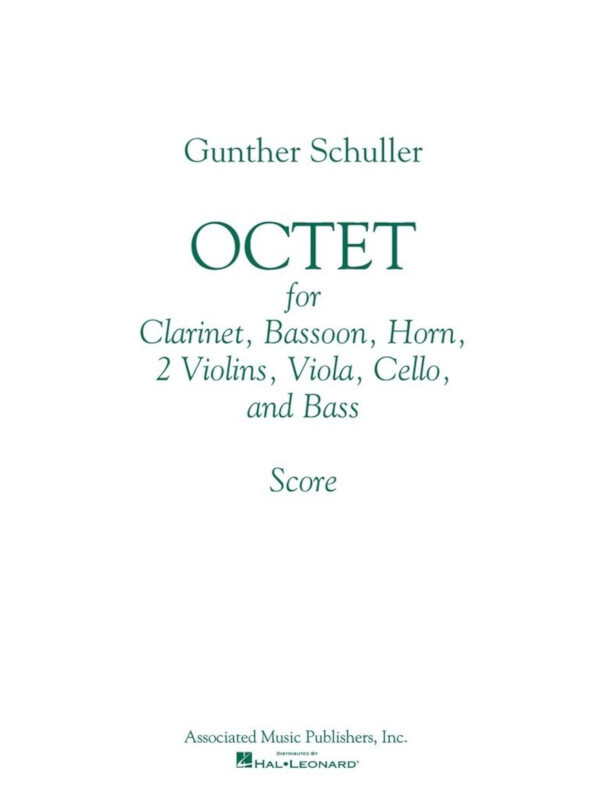 SchirmerStil:
SchirmerStil:  Moderne
Moderne RomantikAusgabe: NotenArt-Nr.: W21037B / HL50481579
RomantikAusgabe: NotenArt-Nr.: W21037B / HL50481579
Dauer: 40 min
Composer Note:
As a horn player, it was my pleasure to play Schuberts Octet many times, and I consider some of those performances of that immortal masterpiece to have had a profound influence on me as a musician. Not surprisingly perhaps, I have wanted for many years to write a piece using the same instrumentation as the Schubert. But it was only when I was asked by the Chamber Music Society of Lincoln Center to compose a work on commission that the ideal opportunity for realizing this long-held dream presented itself.
The work was composed in the spring of 1979 andafter an interruption to write a Trumpet Concerto for Gerard Schwarzin September and early October of that year. It is in four movements, forms in which I made no attempt to break new ground. (I do not believe that composers can be expected to invent new forms every time they write a piece, a notion that certain professional avant-gardists have tried to promulgate for some years. Nor do I believe that the old forms are necessarily exhausted or inappropriate to our contemporary languages, another heavily promoted idea in certain circles.) In any case, though the formal moulds in the Octet may easily be recognized, in their broad outlines, their specific content was not meant to be traditional or neo-classic oras of the latest fashionneo-romantic. It is rather that I feel in matters of expressive content, as well as harmony, melody, rhythm, gesture, continuity, etc., in other words the specific elements of composers have as their creative tools, that they, too, were far from exhausted by nineteenth-and early twentieth-century composers, and not therefore, necessarily, to be discarded as obsolete. However, rather than adopting a neo-classic or neo-romantic approach (which has lately merely meant a return to tonality), I believe in the need to find contemporary analogies to the values and verities of the past. It is not necessary, in order to create something new to abandon or discard everything that came before; at the same time, it is not enough merely to dress the old in new outward appearances, a form of musical plastic surgery. I think the twentieth-century composer, after many years of exciting exploration of the sound world, has now to findwhilst learning from both the distant and recent pastcontemporary analogies to those techniques and values we cherish from the past. That is much the harder task than merely indulging in more experimentation and radical departures (thats easy) on the one hand, or on the other hand in some back to somebody movement. My Octet and many of my other recent (and not so recent) works provide at least a partial personal answer to those difficult questions.
The first movement begins with an introductory Adagio. This subtle, brief bow to Schubert is followed by an Allegro vigoroso which has elements of traditional forms such as exposition, repetition, development section and, to close out the movement, a coda which returns to the mood of the slow opening sectionall in a vigorously chromatic/atonal language.
The second movement follows the venerable scheme of a Theme and Variations, nine of them. Each variation is differentiated by varying tempos, different instruments featured as soloist and contrasting textures and accompanying materials. The instrumentational succession is as follows: theme-clarinet; variation I-horn and bassoon; variation II-first violin; variation III-viola; variation IV-bassoon; variation V-horn; variation VI-cello; variation VII-contrasting the wind and string choirs; variation VIII-contrabass; variation IX-full ensemble (in a well-known European folk ensemble manner). Again, a very brief introduction and a quiet coda surround, like parentheses, the body of the movement.
The third movement is an old-fashioned Scherzo, with three varied statements of the Scherzo proper, a more leisurely Trio and a return to the Scherzo, this time leading to a purposely chaotic and frantic ending.
The last movement begins with a very peaceful Molto adagio, only to erupt into a driving Vivace which dominates the entire movement except for a brief return, just at the end, to the opening tranquility.
Gunther Schuller
Adagio
Theme and Variations
Scherzo
Molto Adagio- Vivace






